The finalists for the Swedish Steel Prize 2019 have now been named and include four revolutionary design concepts that fully utilize the characteristics of premium steel within SSAB’s product range. The winner has been announced at a ceremony in Stockholm last November 14 that celebrates the 20th anniversary of the Swedish Steel Prize.
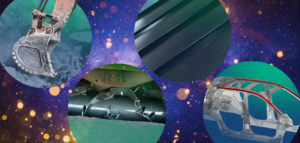
“For the 20th anniversary of the Swedish Steel Prize, the four finalists we have nominated each have a strong connection to a stronger, lighter and more sustainable future. They all show that with new perspectives and innovative thinking comes possibilities to continue moving forward, pushing not only their own industry but also society as a whole,” says Eva Petursson, chair of the Swedish Steel Prize jury and head of SSAB’s research and innovation.
The four finalists and jury motivations were:
Austin Engineering, Australia
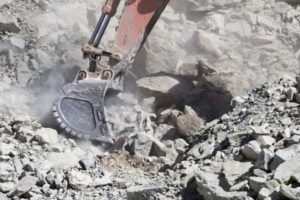 Austin Engineering has taken a significant leap in innovation for the design and maintenance of excavator buckets. With a modular approach, they have developed an innovative concept that combines low weight with optimal use of the complete product before scrapping. The solution utilizes the characteristics of high strength and wear resistant steel and has extremely low barriers for implementation. This clearly opens up for further bucket design innovations.
Austin Engineering has taken a significant leap in innovation for the design and maintenance of excavator buckets. With a modular approach, they have developed an innovative concept that combines low weight with optimal use of the complete product before scrapping. The solution utilizes the characteristics of high strength and wear resistant steel and has extremely low barriers for implementation. This clearly opens up for further bucket design innovations.
Kampag, Brazil
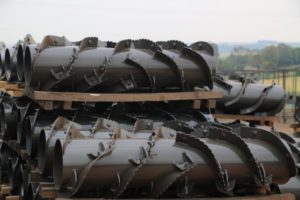 Kampag has managed to increase soya yields by focusing its harvester design on the gentler handling of the crop. A unique feeding modulus unit shows less damage to the harvested bean and also increases machine availability in conditions with high humidity. Additional productivity and sustainability benefits have been realized when upgrading to high strength and wear resistant steel including, increased service life, reduced weight and more lean production as well as maintenance processes with energy savings.
Kampag has managed to increase soya yields by focusing its harvester design on the gentler handling of the crop. A unique feeding modulus unit shows less damage to the harvested bean and also increases machine availability in conditions with high humidity. Additional productivity and sustainability benefits have been realized when upgrading to high strength and wear resistant steel including, increased service life, reduced weight and more lean production as well as maintenance processes with energy savings.
Roofit.solar, Estonia
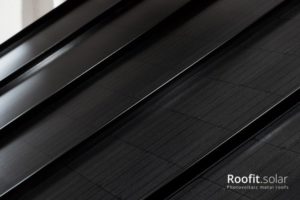 Roofit.solar makes metal solar roofs that produce electricity. The product successfully combines an effective solar panel solution with an architecturally attractive environment friendly steel roof that also enables historical building restorations to benefit from new technological advancements. Using a color coating based on rapeseed oil, it has been possible to push production technology limits and the result shows excellent robust adhesion between the layers of the solar roof panel.
Roofit.solar makes metal solar roofs that produce electricity. The product successfully combines an effective solar panel solution with an architecturally attractive environment friendly steel roof that also enables historical building restorations to benefit from new technological advancements. Using a color coating based on rapeseed oil, it has been possible to push production technology limits and the result shows excellent robust adhesion between the layers of the solar roof panel.
Shape Corporation, USA
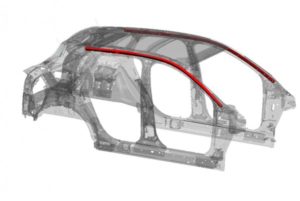 Shape has developed a cost effective and robust manufacturing process for 3D shaped tubes that makes it possible to utilize cold forming steels with the highest strength levels currently in existence. With this technology, a unique lightweight solution for A-pillar and roof rail tubes, with minimal section size, is now ready for implementation by a major automotive manufacturer during 2020. This pioneering innovation will challenge other lightweight materials with a much more sustainable steel solution that allows for circular material flows.
Shape has developed a cost effective and robust manufacturing process for 3D shaped tubes that makes it possible to utilize cold forming steels with the highest strength levels currently in existence. With this technology, a unique lightweight solution for A-pillar and roof rail tubes, with minimal section size, is now ready for implementation by a major automotive manufacturer during 2020. This pioneering innovation will challenge other lightweight materials with a much more sustainable steel solution that allows for circular material flows.
And the winner is…
Shape Corp. named Swedish Steel Prize 2019 finalist
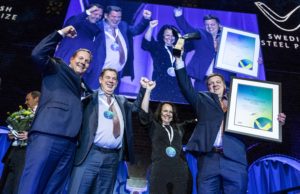 For developing a unique manufacturing process and a lightweight solution for A-pillar and roof rail tubes in cars, Shape Corp. has been nominated for the Swedish Steel Prize 2019.
For developing a unique manufacturing process and a lightweight solution for A-pillar and roof rail tubes in cars, Shape Corp. has been nominated for the Swedish Steel Prize 2019.
“In the mid-2000s we developed bending technology that could bend in one direction in the same plane, in line with our roll forming process. We called it 1D bending, and over the next few years this technology progressed to handling bending in two directions on the same plane – and then three directions. We call it 3D bending,” explains Brian Oxley, Product Manager at Shape Corp.
In 2011, Shape Corp. approached Ford with the profile concept, and it resulted in 3D roll-formed A pillars, made from cold rolled 1,700 MPa martensitic steel, which are currently being used in a number of Ford vehicles, including the Ford Explorer and Ford Escape. Also Docol® 1700M steel will be part of the application.
Traditionally, these types of automotive applications are hydroformed, however, doing so can mean limitations in terms of material strength and production efficiency. Instead, the tube is three dimensionally bent after roll forming and remote laser welded into sub-assembly for integration into the A-pillar and roof rail area in the vehicle safety cage for impact protection.
Thanks to 3D forming, the A pillars feature smaller profiles than traditional solutions, allowing for better driver visibility, more interior space as well as better packaging of airbags. The 3D formed A-pillars also have an improved strength to weight ratio of over 50 percent, which has led to an overall mass reduction of 2.8-4.5 kg per vehicle.
Shape Corp.’s highly innovative technology and use of steel has been proven viable within the global automotive industry and represents a major leap forward in both car safety and automotive design.
“We have taken the highest strength steel on the market and combined it with the perfect application – a bit like pairing wine with food,” explains Oxley. “The results are very tangible in terms of mass savings, but it also shows the industry what is possible with these advanced grades – and that steel will have a place in automotive for a long time to come.”
The Swedish Steel Prize jury’s motivation for selecting Shape Corp as a finalist for the Swedish Steel Prize 2019 is:
Shape has developed a cost effective and robust manufacturing process for 3D shaped tubes that makes it possible to utilize cold forming steels with the highest strength levels currently in existence. With this technology, a unique lightweight solution for A-pillar and roof rail tubes, with minimal section size, is now ready for implementation by a major automotive manufacturer during 2020. This pioneering innovation will challenge other lightweight materials with a much more sustainable steel solution that allows for circular material flows.



